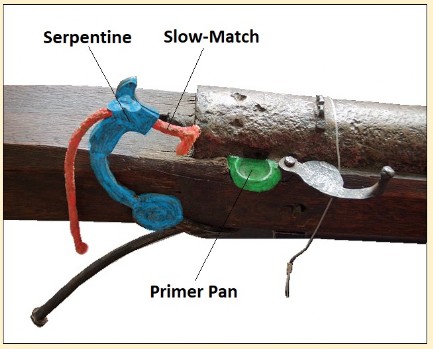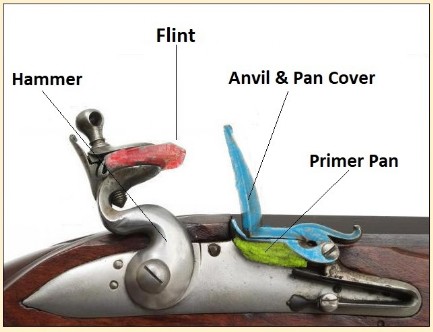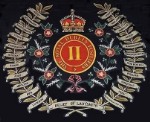What was a Fusilier?
The firearm in general use by the English Army in the mid-seventeenth century was the matchlock musket. This weapon descended from the fifteenth century arquebus. Matchlock muskets are fired by means of a cord with a smoldering tip known as a "slow-match." The match is threaded through a serpentine hammer which is released downward to the priming pan when the trigger is pulled. Gunpowder in the priming pan ignites when it meets the smoldering end of the match. Powder runs in a channel from the priming pan to the gunpowder charge in the barrel and acts as a quick-firing fuse. The charge explodes which propels the ball (bullet) through the barrel towards the enemy.

Photograph by Rainer Halama, 2008, edited. Public domain, GFDL-Creative Commons.
When advancing into action, or marching through hostile territory, soldiers bore their match lighted at both ends to constantly preserve a light as firing extinguished the light on the primer pan end of the match.
The flintlock mechanism, also called fusil, gradually superseded the matchlock. The name "fusil" is from the Spanish fusil, which was in turn taken from focile, the Italian word for flint. The principle of the fusil is employment of a flint hammer and a steel anvil in lieu of a match cord. The flint is held in place by a cock which is released when the trigger is pulled. The flint comes down on the anvil driving it back and opening the priming pan into which falls the sparks emitted by the blow. The priming powder ignites and sets off the explosion in the barrel.

Original image by “Engineer comp geek,” 2009, edited. Public domain, GFDL-Creative Commons.
The flintlock was a great improvement over the matchlock. Problems with the matchlock mechanism were many: The glowing match ruled out surprise night attacks. Soldiers had to keep the match smoldering in rainy weather. On windy days the priming powder would be blown from the open primer pan (and the powder was also exposed to rain). Lastly, the large quantity of slow-matches required by an army in the field significantly increased supply requirements. All these defects were avoided by the fusil.
n/ Clifford Walton, History of the British Standing Army, 1660 to 1700 (London: Harrison, 1894), 328-33.
In May 1685, James Scott, the Duke of Monmouth, raised a rebel army in southwest England to dethrone King James II. By June, Monmouth had a force of 1,000 men and on the 16th of that month defeated the Dorset militia, which had been mobilized to suppress the rebellion. The insurrection caused something like a panic in London and Parliament authorized James to expand the English army. Among the new army formations was an "Ordnance Regiment" charged by James II to care for and protect the army's canon and gunpowder. The king further ordered that the armament of this regiment be superior to that of the ordinary infantry battalions. Accordingly, its first contingent, two companies of Tower Guards, was armed with flintlock fusils. James named this artillery guard the "Royal Regiment of Fuzileers." The regiment quickly attracted recruits from the London area and on July 4th reached its authorized strength of 1,350 officers and men organized into 12 companies and all armed with fusils. By August 1685, the rebellion had been crushed and Monmouth beheaded. The government kept the Royal Fusiliers on the army establishment but reduced its strength to 700.
n/ Percy Groves, Historical Records of the 7th or Royal Regiment of Fusiliers (Guernsey: Guerin, 1903), 1-5.
Over time, flintlock muskets became the British Army's standard firearm, and the regimental designation "fusilier" lost its armamental meaning. As the army establishment considered the Royal Fusiliers an elite formation, the term "fusilier" became an honorific. In 1840 the British East India Company designated the 1st Madras Europeans (antecedent of the 1st Battalion, Royal Dublin Fusiliers) a fusilier regiment. In 1844 the Company similarly honored the 1st Bombay Europeans (2nd Battalion, Royal Dublin Fusiliers).
On Bloomsday, nine regiments had fusilier designation; one Scotch, one Welsh, three English, and four Irish. The Irish regiments in addition to the "Dublins" were the Royal Inniskilling Fusiliers, Royal Irish Fusiliers, and the Royal Munster Fusiliers.
[ You are at www.majortweedy.com>Royal Dublin Fusiliers>Fusiliers? ]
